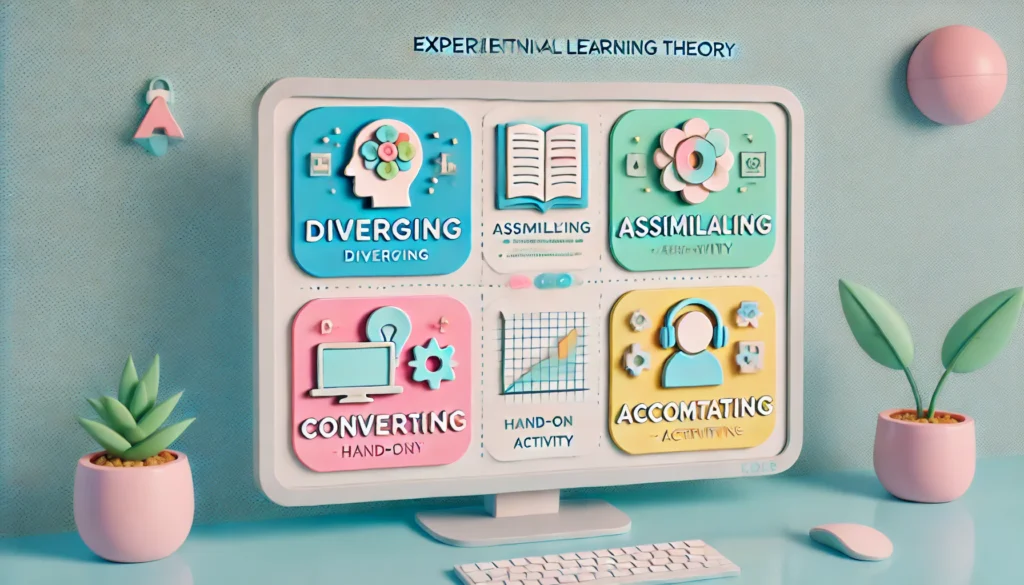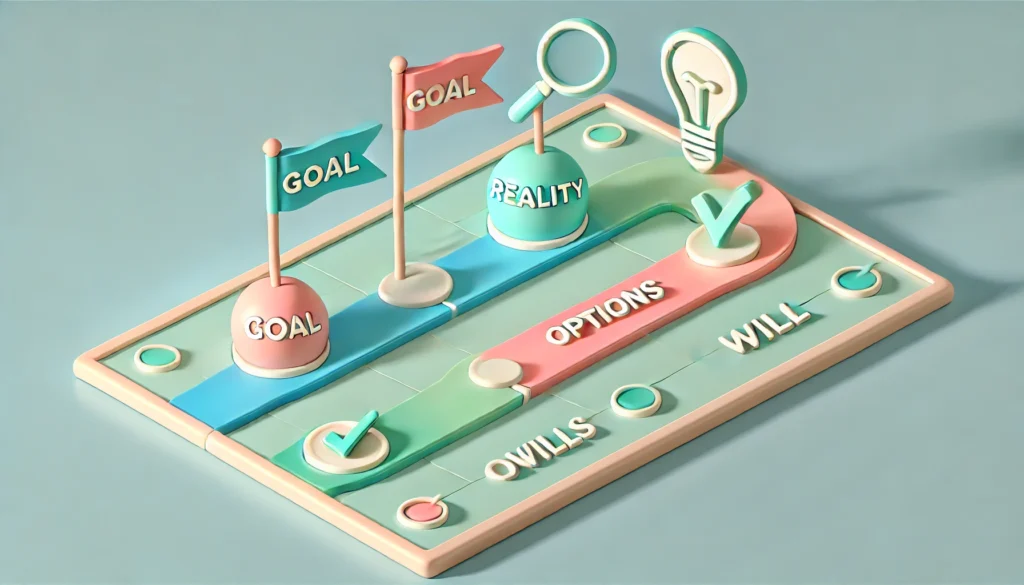Picture this: It’s the start of a new year, and instead of diving headfirst into yet another set of generic goals, you’ve crafted a learning plan that’s uniquely yours. This plan not only aligns with your aspirations but also respects your need for balance—where growth and reflection go hand in hand, and rest fuels your progress. In today’s fast-paced world, the key to sustainable learning isn’t just about efficiency; it’s about having a personalized learning plan that fits your approach to your life, needs, and goals.
In this guide, we’ll walk you through creating a personalized learning plan that not only boosts your skills but also enhances your overall well-being. By the end, you’ll have a clear, actionable strategy for 2024 that balances productivity with mindfulness, ensuring sustainable and meaningful progress. Let’s dive in.
Understanding Your Learning Style with Kolb’s Model
To create a truly personalized learning plan, it’s crucial to understand how you learn best. While traditional models like VAK (Visual, Auditory, Kinesthetic) have been popular, they often oversimplify the complex process of learning. Instead, Kolb’s Experiential Learning Theory offers a more dynamic approach, focusing on how learners process and internalize information through experiences.
“Kolb’s model provides a robust framework that helps learners identify their strengths and tailor their learning strategies accordingly,” says Dr. Roger M. Bennett, an educational psychologist. “This personalized approach ensures that learning is not just effective but also engaging.”
Kolb identifies four primary learning styles: Diverging, Assimilating, Converging, and Accommodating. Here’s a brief look at each:
- Diverging: Learners who excel in seeing things from multiple perspectives. They prefer to observe rather than act and are often imaginative and emotional. Diverging learners thrive in brainstorming sessions and group discussions where they can explore different viewpoints.
- Assimilating: These learners prefer a concise, logical approach. Concepts and ideas are more important than people, and they excel in organizing information and creating theoretical models. Assimilating learners benefit from structured learning environments where they can focus on developing and understanding complex concepts.
- Converging: Converging learners are practical problem-solvers. They prefer technical tasks over social or interpersonal issues and excel in applying ideas in a practical, real-world context. These learners thrive in environments where they can experiment and engage in hands-on activities.
- Accommodating: These learners rely more on intuition than logic. They are often flexible, open to new experiences, and excel in adapting to changing circumstances. Accommodating learners prefer to learn by doing and are most comfortable when they can actively engage in new experiences.

Real-World Application: Understanding your position within Kolb’s model can significantly enhance the effectiveness of your learning plan. For example, if you’re a Diverging learner, you might focus on incorporating more group discussions, case studies, and reflective practices into your plan. Conversely, if you identify with the Converging style, you might prioritize hands-on projects, experiments, and real-world applications of what you’re learning.
Practical Example: Take the case of Sarah, a graduate student who struggled with traditional study methods. After identifying herself as an Assimilating learner, she shifted her focus from rote memorization to creating detailed concept maps and summaries. This not only improved her understanding of complex theories but also boosted her retention, leading to better performance in her exams.
By recognizing and embracing your learning style, you can tailor your learning experiences to match your natural tendencies, making your study sessions more effective and enjoyable.
Setting Learning Goals Using the GROW Model
Once you’ve identified your learning style, the next step is setting clear, actionable goals. While SMART goals (Specific, Measurable, Achievable, Relevant, Time-bound) are popular, the GROW model offers a more learning-oriented framework that’s particularly useful for personal development.
The GROW model stands for Goal, Reality, Options, and Will, and it provides a structured approach to setting and achieving your learning goals:
- Goal: Start by defining what you want to achieve in your learning journey. This could be mastering a new skill, gaining proficiency in a language, or advancing in your career. The key is to be clear and specific about what success looks like.
- Reality: Assess your current situation. Where do you stand in relation to your goal? What skills or knowledge do you already have, and what gaps need to be filled? This step involves honest self-reflection to understand your starting point.
- Options: Explore the different strategies and resources available to help you achieve your goal. Consider online courses, books, workshops, or even mentorship. This is where creativity comes into play—think broadly about the various paths you could take.
- Will: Finally, commit to an action plan. Set a timeline with milestones and checkpoints to track your progress. This step is about turning your goals into actionable steps and ensuring you have the motivation and resources to follow through.
Real-World Application: The GROW model helps you stay focused and motivated by breaking down goals into manageable steps and regularly reviewing progress. It’s particularly useful when tackling complex learning objectives that require sustained effort over time.

Practical Example: Consider John, a software engineer aiming to learn a new programming language. Using the GROW model, he set a clear goal of becoming proficient in Python within six months. He assessed his current knowledge, identified the best online courses and practice projects, and created a detailed action plan with weekly targets. By regularly reviewing his progress and adjusting his approach as needed, John was able to achieve his goal ahead of schedule.
“Effective goal-setting is at the heart of any successful learning strategy,” emphasizes Dr. Carol Dweck, a renowned psychologist known for her work on growth mindset. “The GROW model helps learners to align their goals with their personal and professional growth, making their personalized learning plan more meaningful.”
By applying the GROW model, you can ensure that your learning goals are not only clear and achievable but also aligned with your personal and professional aspirations.
Incorporating Journaling and Reflection
Learning is not just about absorbing new information; it’s also about reflecting on what you’ve learned and how you’re progressing. Journaling and reflection are powerful tools that can deepen your understanding, track your progress, and help you identify areas for improvement.
Explanation: Journaling allows you to document your learning experiences, thoughts, and insights. It’s a way to process what you’ve learned, explore new ideas, and connect different concepts. Reflection, on the other hand, involves looking back at your learning journey to evaluate what’s working, what’s not, and how you can improve.

Real-World Application: Regular journaling and reflection can enhance your learning by helping you internalize new information and develop a deeper understanding of the material. It also provides a space for you to track your progress, celebrate your successes, and address any challenges you encounter along the way.
Practical Example: Emma, a lifelong learner, used daily journaling to reflect on her experiences while studying for a professional certification. Each day, she noted what she learned, how she felt about the material, and any questions or insights that arose. Over time, her journal became a valuable resource, helping her identify patterns in her learning and make adjustments to her study methods. By reflecting regularly, Emma was able to stay focused, motivated, and ultimately pass her certification exam with flying colors.
“Reflection is a critical component of effective learning,” states Dr. Donald Schön, a professor and reflective practitioner. “It enables learners to internalize their experiences, thereby enhancing the value of their personalized learning plan.”
Balancing Learning with Rest and Downtime
In our quest for productivity, it’s easy to overlook the importance of rest and downtime. However, these are crucial components of any effective learning plan. Just as muscles need rest to grow stronger, your brain needs time to process and consolidate new information.
Explanation: Rest and downtime are essential for cognitive processing, memory consolidation, and preventing burnout. When you take breaks, your brain has a chance to recharge, making you more focused and productive when you return to your studies.
Real-World Application: Incorporating rest into your learning schedule can enhance your overall performance. This might involve using techniques like the Pomodoro Technique, where you work in short, focused bursts followed by regular breaks, or scheduling full days off to allow your brain to recover.
Practical Example: Alex, a busy professional, found himself on the brink of burnout after juggling work, family responsibilities, and a demanding online course. By restructuring his schedule to include regular breaks and downtime, Alex noticed a significant improvement in his focus and retention. He began using the Pomodoro Technique to work in 25-minute intervals, followed by 5-minute breaks, and reserved Sundays as a rest day. This balance of work and rest not only prevented burnout but also made his learning more effective.
By prioritizing rest and downtime, you can maintain a sustainable learning pace that supports long-term growth and well-being.

Leveraging Technology and Resources
In today’s digital age, technology offers an abundance of tools and resources that can enhance your learning experience. From online courses to AI-powered learning platforms, there are countless ways to personalize your learning plan and make it more efficient and engaging.
Explanation: Technology can play a pivotal role in your learning journey by providing access to a wide range of resources, enabling personalized learning paths, and offering flexibility in how and when you learn. Whether it’s through video tutorials, interactive simulations, or online communities, technology can cater to your specific learning needs and preferences.
Real-World Application: To make the most of these tools, it’s important to choose platforms and resources that align with your learning style and goals. For instance, visual learners might benefit from video courses on platforms like Coursera or Khan Academy, while hands-on learners might prefer interactive coding platforms like Codecademy.
Practical Example: Maria, a marketing professional, used a combination of apps and online platforms to build a diversified learning plan that fit her busy schedule. She used Duolingo to practice a new language during her commute, LinkedIn Learning for professional development courses, and Anki for spaced repetition flashcards. By integrating these tools into her daily routine, Maria was able to make consistent progress without feeling overwhelmed.
Leveraging technology allows you to create a more flexible, personalized, and efficient learning experience, making it easier to achieve your goals.
Conclusion
Creating a personalized learning plan is about more than just setting goals; it’s about understanding how you learn, reflecting on your progress, balancing productivity with rest, and leveraging the tools at your disposal. By incorporating Kolb’s learning styles, the GROW model, journaling, rest, and technology into your plan, you can design a learning journey that’s not only effective but also sustainable and enjoyable.
As you embark on your learning journey in 2024, start by assessing your learning style with Kolb’s model and setting your first learning goal using the GROW framework. Incorporate journaling to reflect on your progress, ensure you build rest into your schedule, and explore the many technological tools available to support your learning. With a well-rounded, personalized approach, you’ll be well on your way to achieving your goals and growing both personally and professionally.
